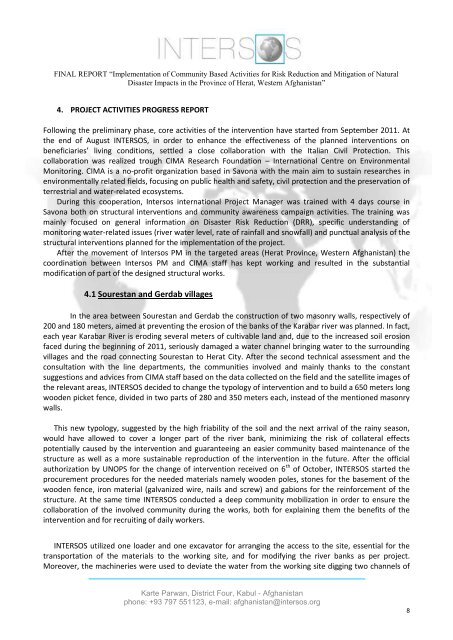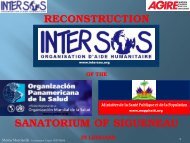Implementation of Community Based Activities for Risk ... - Agire
Implementation of Community Based Activities for Risk ... - Agire
Implementation of Community Based Activities for Risk ... - Agire
You also want an ePaper? Increase the reach of your titles
YUMPU automatically turns print PDFs into web optimized ePapers that Google loves.
FINAL REPORT “<strong>Implementation</strong> <strong>of</strong> <strong>Community</strong> <strong>Based</strong> <strong>Activities</strong> <strong>for</strong> <strong>Risk</strong> Reduction and Mitigation <strong>of</strong> NaturalDisaster Impacts in the Province <strong>of</strong> Herat, Western Afghanistan”4. PROJECT ACTIVITIES PROGRESS REPORTFollowing the preliminary phase, core activities <strong>of</strong> the intervention have started from September 2011. Atthe end <strong>of</strong> August INTERSOS, in order to enhance the effectiveness <strong>of</strong> the planned interventions onbeneficiaries’ living conditions, settled a close collaboration with the Italian Civil Protection. Thiscollaboration was realized trough CIMA Research Foundation – International Centre on EnvironmentalMonitoring. CIMA is a no-pr<strong>of</strong>it organization based in Savona with the main aim to sustain researches inenvironmentally related fields, focusing on public health and safety, civil protection and the preservation <strong>of</strong>terrestrial and water-related ecosystems.During this cooperation, Intersos international Project Manager was trained with 4 days course inSavona both on structural interventions and community awareness campaign activities. The training wasmainly focused on general in<strong>for</strong>mation on Disaster <strong>Risk</strong> Reduction (DRR), specific understanding <strong>of</strong>monitoring water-related issues (river water level, rate <strong>of</strong> rainfall and snowfall) and punctual analysis <strong>of</strong> thestructural interventions planned <strong>for</strong> the implementation <strong>of</strong> the project.After the movement <strong>of</strong> Intersos PM in the targeted areas (Herat Province, Western Afghanistan) thecoordination between Intersos PM and CIMA staff has kept working and resulted in the substantialmodification <strong>of</strong> part <strong>of</strong> the designed structural works.4.1 Sourestan and Gerdab villagesIn the area between Sourestan and Gerdab the construction <strong>of</strong> two masonry walls, respectively <strong>of</strong>200 and 180 meters, aimed at preventing the erosion <strong>of</strong> the banks <strong>of</strong> the Karabar river was planned. In fact,each year Karabar River is eroding several meters <strong>of</strong> cultivable land and, due to the increased soil erosionfaced during the beginning <strong>of</strong> 2011, seriously damaged a water channel bringing water to the surroundingvillages and the road connecting Sourestan to Herat City. After the second technical assessment and theconsultation with the line departments, the communities involved and mainly thanks to the constantsuggestions and advices from CIMA staff based on the data collected on the field and the satellite images <strong>of</strong>the relevant areas, INTERSOS decided to change the typology <strong>of</strong> intervention and to build a 650 meters longwooden picket fence, divided in two parts <strong>of</strong> 280 and 350 meters each, instead <strong>of</strong> the mentioned masonrywalls.This new typology, suggested by the high friability <strong>of</strong> the soil and the next arrival <strong>of</strong> the rainy season,would have allowed to cover a longer part <strong>of</strong> the river bank, minimizing the risk <strong>of</strong> collateral effectspotentially caused by the intervention and guaranteeing an easier community based maintenance <strong>of</strong> thestructure as well as a more sustainable reproduction <strong>of</strong> the intervention in the future. After the <strong>of</strong>ficialauthorization by UNOPS <strong>for</strong> the change <strong>of</strong> intervention received on 6 th <strong>of</strong> October, INTERSOS started theprocurement procedures <strong>for</strong> the needed materials namely wooden poles, stones <strong>for</strong> the basement <strong>of</strong> thewooden fence, iron material (galvanized wire, nails and screw) and gabions <strong>for</strong> the rein<strong>for</strong>cement <strong>of</strong> thestructure. At the same time INTERSOS conducted a deep community mobilization in order to ensure thecollaboration <strong>of</strong> the involved community during the works, both <strong>for</strong> explaining them the benefits <strong>of</strong> theintervention and <strong>for</strong> recruiting <strong>of</strong> daily workers.INTERSOS utilized one loader and one excavator <strong>for</strong> arranging the access to the site, essential <strong>for</strong> thetransportation <strong>of</strong> the materials to the working site, and <strong>for</strong> modifying the river banks as per project.Moreover, the machineries were used to deviate the water from the working site digging two channels <strong>of</strong>Karte Parwan, District Four, Kabul - Afghanistanphone: +93 797 551123, e-mail: afghanistan@intersos.org8




